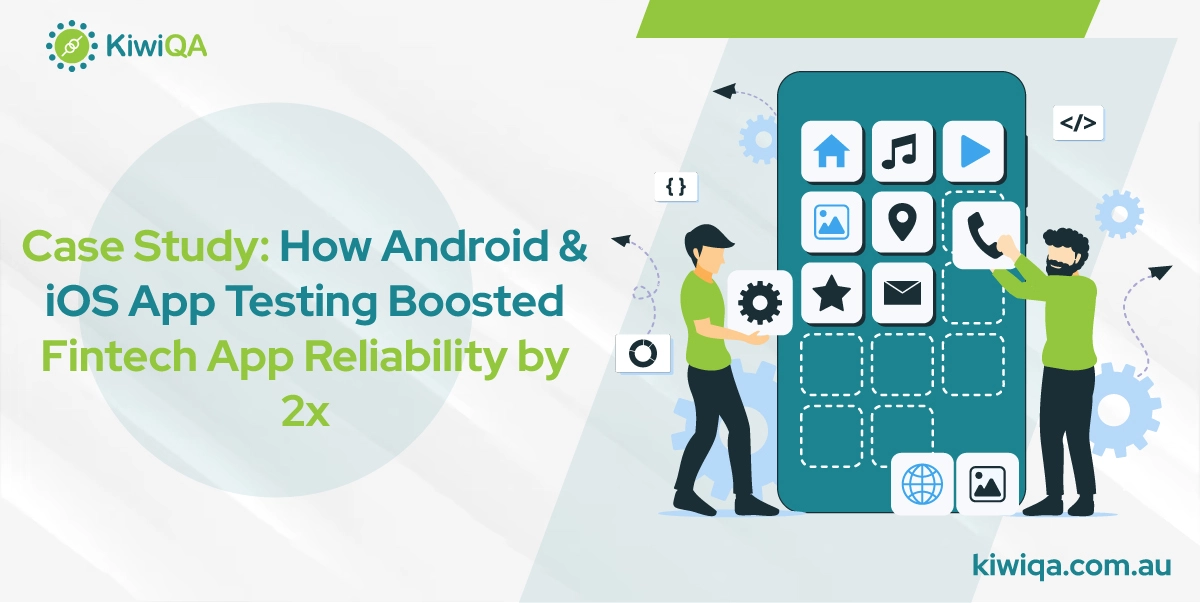Case Study: How Android & iOS App Testing Boosted Fintech App Reliability by 2x

 KiwiQA
KiwiQAThe fintech industry is counted among the frequently evolving sectors that involve innovation in banking, insurance & payment management. Market reports declared the demand for the Fintech industry is driving, with a 17.5% CAGR from 2023 to 2030. Fintech mobile apps are complex & highly regulated, and that’s why they require more security. Fintech app testing is necessary since it manages sensitive financial information. Test automation is the necessary tactic of a Fintech organization, as the team needs to validate functionalities & enhance user experience in a highly competitive environment.
Hundreds of new fintech apps are launched on iOS & Android frequently. Every time users download these apps, they expect a seamless operation. Well, a small glitch in your app can destroy the reputation & users’ trust. Do you know that Commerzbank AG was penalized for £37.8 million, since it failed to incorporate an effective crime control system by the FCA? Before deploying an app, it’s necessary to test the fintech app on the basis of functionality, performance, & safety. This comprehensive guide leverages the App Testing case study of a Fintech company, choosing testing to boost their app reliability by 2X.
With the rising utilization of smartphones, the popularity of fintech apps is driving. It has undergone massive growth in the past years. Fintech apps offer lots of benefits like easy access to financial data, secure & quick payments. We’ll share about the App Testing Case Study benefits in the section below. However, these benefits come with rigorous testing. Fintech apps face unique challenges in the real world. So, before releasing, it’s the responsibility of the organization to guarantee that the app is trustworthy, secure & satisfies user needs.
Today, we’ll discuss the Fintech app testing project, ATN WAYYA. This is a Nigerian project that offers “online billings & e-money transfer services to users. Various end-users and the operational team use this app for their internal banking system. This application is available for both iOS & Android platforms. It has an admin panel for web portals also. The app targets audiences like retail users, B2C & enterprise. The app mainly offers services like deposit, withdrawal, super/sub agent onboarding, NIN/BVN retrieval, wallet funding, etc. It also showcases the transactional history & forgot/changed MPIN.
The business objective was to deliver a secure and scalable banking/fintech app to users. The client wanted to ensure a seamless, cross-platform experience with reduced downtime & app crashes. Let’s take a brief about the goals of the Application Testing case study:
High amounts of transactions must be handled well by fintech systems, particularly during busy times like pay distributions or market swings. Performance testing guarantees scalability and real-time processing by confirming that applications can handle such loads without degrading. The payment systems of Visa operate 65,000 transactions per second, which highlights the necessity of performance testing in Fintech apps.
We use multiple devices, from smartphones to smartwatches, for accessing FinTech applications. Testing guarantees that the application functions flawlessly on all platforms. It guarantees that there are no functional variations between the online and mobile versions and that the UI/UX stays consistent and accessible.
When testing financial apps, security is still the most important consideration because any flaw during transactions could result in data breaches and erode user confidence. Fintech mobile apps store confidential data, such as personal and banking data. Testers must conduct comprehensive security testing in order to find weaknesses and defend against possible threats such as malware, hacking, data leaks, and unauthorized access. Fintech app compliance testing is necessary since it verifies that the digital payments sector is following industry standards.
Glitches & software bugs damage user trust since they frustrate users & make them lose trust in the product’s reliability. It can lead to app abandonment, decrease engagement & ROI. FinTech apps handle sensitive data that can’t be accessed, such as PII and credit card numbers, necessitating high security requirements. Testing should guarantee hiding data, encryption, and safe storage to stop breaches and preserve confidence.
Low application store ratings negatively impact the adoption by limiting the app’s visibility in search results. It minimizes the chances of users’ adoption rate due to poor quality, which ultimately leads to revenue and fewer downloads. Most users check the rating of the application before downloading. Fintech apps that have fewer than 3 stars are mostly termed as “worst”. Low visibility leads to few downloads, limits opportunities for positive reviews & poor ratings.
Regulations such as GDPR, PCI DSS, and SOX must be followed by fintech applications in order to handle data securely and have audit trails. The Regulatory App Testing case study represents a crucial area of concern because non-compliance carries significant fines and reputational damage. It limits the chances of legal issues & guarantees safe transactions, data protection, and integrity.
Also Read: How to Choose the Right Software Testing Outsourcing Partner
➺ Functional Testing: This is the foundation of testing fintech apps over Android & iOS. We adopt the testing to verify that all functionalities are working together with APOs, the integrated system. The testing focuses on the core features like user login & in-app purchases. It manages error handling & maintains user flow. Test your fintech application to ensure the users can conveniently transfer the amount and use payment methods.
➺ Performance Testing: Since the company was concerned about how the application performs under various conditions, we approached performance testing. Performance testing assists organizations in seeing how their fintech app handles a large volume of transactions. It is also termed as stress/load testing by simulating the extreme conditions such as low battery & limited memory. When it comes to measuring app responsiveness, consider screen transitions and app loading. If your fintech app is equipped with multiple videos for training, see how these work during peak timings & slow connections.
➺ Security Testing: security testing includes app testing for vulnerabilities & safeguarding user data. The testing aims to verify that the sensitive user’s data is encrypted and test the login mechanisms. It makes sure that only verified users can access the app. Furthermore, we performed security testing for the Fintech app to address the common loopholes like insecure data storage & SQL injection and ensure that their app fulfills all the compliances. This is how we assured our client that their app is encrypted & authenticated.
➺ Compatibility Testing: Compatibility testing helped us ensure the compatibility of the Client’s Fintech app. Testing ensures the app can seamlessly run on multiple iOS & Android devices. The testing focuses on whether the application works on older versions with various hardware configurations. The QA team frequently uses this tactic to ensure that the UI displays correctly across the various resolutions in both portrait & landscape mode.
➺ Automation Testing: The following testing approach is used for running automated predefined test cases & getting quick outcomes. Automation is the faster & efficient way of manual testing. This is the way to perform repetitive tasks like regression testing, in a faster & efficient way. Automation testing is the easier way to scale & run multiple devices. Automation testing is resource-intensive. Some of the most common frameworks the QA team chose for the Fintech app testing project are- Detox, Appium, XC Test, etc.
When automating FinTech applications, selecting the appropriate automation tool is essential. One kind of testing is supported by traditional automation tools. The team must therefore maintain various testing tools for each sort of testing, which raises the overall cost and labor of maintenance. It is challenging to manage all of these automation frameworks, which may be developed in several programming languages, because FinTech apps are more dynamic. Here are some basic automation testing tools & technologies used:
For testing Fintech apps over an Android phone, our team used Espresso & Appium tools. Appium, the client-server QA tool, can be accessed for free. Appium is an excellent option if you’re looking for a tool compatible with all programming languages. Because its server is based on Node.js, it is compatible with widely used languages, including Python, Java, and Ruby. Google offers Espresso as a free tool. It addresses automating Android UI tests and facilitates the creation of Android apps by giving developers the ability to create automation test cases.
To test the iOS fintech application, the testing team used the following tests for the following reasons-
The XCTest framework, which Apple provides for unit and user interface testing of iOS and macOS applications, includes the functions XCTest and XCUITest. They have distinct functions within the testing ecosystem, though.
Developers may test even the smallest components of an application with XCTest. This involves testing certain features and procedures to make sure they operate as intended in a range of scenarios. XCUITest offers the quickest implementation for iOS devices because it is integrated directly into the Xcode IDE. Appium, the automation framework, is good for testing native iOS and Android apps. It allows the team to test on both real devices and emulators/simulators.
For cross-platform Fintech app testing, the team incorporated tools like BrowserStack & Firebase Test Lab. BrowserStack was used to emphasize the wide range of real devices for mobile/web testing, whereas Firebase Test Lab focuses on testing on real & virtual devices. Both frameworks support automation that helps generate test scripts. BrowserStack allows various integrations, whereas Firebase Test Lab is only integrated across various development environments.
For CI/CD integration, our team’s first preference was Jenkins and GitHub Actions. GitHub Actions is a cloud-based service that is connected with GitHub, whereas Jenkins is usually self-hosted and provides greater control over the environment. Jenkins needs plugins for comparable integrations, whereas GitHub Actions provides a native connection with GitHub capabilities.
First, we identify the critical fintech workflows, such as payment transfer, login, and KYC. Our team collaborated with the business stakeholders to describe the critical workflow. The team then identifies cross-platform priorities such as device fragmentation, compliance needs & network variations. After concluding the requirement, we create the risk-based strategy for focusing on high-value transactions & security compliance.
In the following step, the team creates the detailed test cases involving both functional & non-functional aspects. Create and organize the test cases with precise operation, expected results, & prerequisites.
In this step, our team designs automation scripts for both Android & iOS platforms. Establish the testing with both devices, covering multiple OS versions and screen sizes. The team integrated the cloud-based devices to offer better scalability. The team adopted Appium+ TestNG for cross-platform automation. Integrate CI/CD pipelines for regression testing.
Software testing that continuously ensures the product’s quality at every step of development is known as continuous testing. Continuous testing methodology is a component of the CI/CD process that facilitates early problem detection, shortens programmer feedback cycles, enhances quality, visibility, and speeds up time to market.
This phase involves generating official test reports to convey findings in the Android & iOS App Testing case study. Bug reports, UX remarks, and feature requests are important components of feedback. Similarly, test reports provide stakeholders with an overview of test case execution, defect logs, and overall product quality.
Also Read: Objective of Integration Testing: Safeguarding Customer Experience and Trust
After adopting & implementing the following practices, we have achieved the following results in our iOS App Testing Case Study:
The app showed a sudden reliability by 2X, which was the objective of our Android &iOS App Testing Case Study.
A sudden reduction in app downtime was noticed by 40%.
Integration of automation drives 60% of faster release cycles.
30% improvement noticed in fintech app rating.
After fintech app testing, the business improved its reliability & seamless cross-platform performance. The brand has witnessed strong customer loyalty, limited transaction failures, and enhanced error-free transactions. The business retention increased by 40%
The daily transaction rate in the fintech app has also improved. More & more users are engaging with the application to complete regular transaction requirements.
By delivering a better fintech app, the client has witnessed a stable & secure mobile application. With the right testing approaches, businesses can fulfill the compliance gaps and reduce the chances of a crash. After testing, the fintech company shared that they got the best rating, & brand credibility, and reputation.
A software testing technique called cross-platform testing makes sure an application runs as expected on several platforms. In order to confirm functionality, reliability, accessibility, and performance, the tester must run the product across a range of devices, operating systems, and browser combinations.
Automation ensures constant task performance and removes manual errors, greatly decreasing human error. By expediting procedures and releasing human labor, it also speeds up delivery. This is accomplished by replacing consistent, accurate procedures for repetitive tasks, which results in increased accuracy and quicker completion times.
Data protection & data encryption are both necessary to safeguard the financial data of clients. For safeguarding fintech apps, security testing is non-negotiable. Security testing is necessary to identify and address threats like data breaches, fraud & unauthorized access.
This is essential for delivering real-time feedback on system health and promptly identifying and addressing new threats and problems. It maintains excellent performance and user happiness while guaranteeing continuous security and compliance.
AI is revolutionizing software quality assurance by improving accuracy and efficiency. It shortens time-to-market by speeding up the process of verifying product features. However, choosing the best AI-powered solutions that provide long-term value and making a careful infrastructure investment are necessary for expanding AI-driven test automation.
The industry must address technological and usability constraints by creating new display technologies in order to increase coverage for wearables and foldables. It creates integration protocols for smooth device interoperability and enhances power management for extended battery life.
Bringing the testing stage considerably earlier in the SDLC is the goal of the shift-left testing concept. The shift-left strategy seeks to increase quality. By testing frequently, identifying problems, and reducing risks early on, it integrates testing earlier in the SDLC. Therefore, compared to conventional testing methods, a move to the left in testing may be a more practical way to find product flaws.
The FinTech industry frequently grows, and it becomes important to evaluate how financial services will develop in the future. Frequent innovation in testing strategies & tools is necessary to keep up with threats & challenges. Collaboration between the development & QA team is necessary to foster the security & performance of the application.
It is necessary to contact the expert testing professional for verifying security & compliance. The Android & iOS app testing helped a fintech business to achieve 2X reliability. Hope this Application Testing case study encourages your business to invest in the structured QA for fintech apps.
Subscribe to our newsletter for some hand-picked insights and trends! Join our community and be the first to know about what's exciting in software testing.
Welcome to the testing tales that explore the depths of software quality assurance. Find valuable insights, industry trends, and best practices for professionals and enthusiasts.

Fill out and submit the form below, we will get back to you with a plan.
 CRN:
22318-Q15-001
CRN:
22318-Q15-001 CRN:22318-ISN-001
CRN:22318-ISN-001 CRN:22318-IST-001
CRN:22318-IST-001